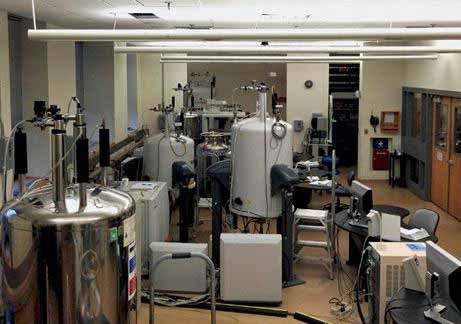Two grants totaling approximately $1.5 million will support the installation of two state-of-the-art nuclear magnetic resonance spectrometers in the Magnetic Resonance Center in the Merkert Chemistry Center, according to center director Thusitha Jayasundera.

The Magnetic Resonance Center
The funding from the National Institutes of Health and the National Science Foundation will facilitate the purchase of two instruments that allow researchers to study the physical, chemical, and biological properties of matter. Chemists, in particular, use NMR spectroscopy to determine molecular identity and structure.
“These grants will help us support a range of research we do here at Boston College, particularly our researchers working with funding from the National Institutes of Health,” said Jayasundera. “These are important upgrades in our capabilities that give our faculty, graduate students, undergraduates, and even visiting high school students the chance to work with state-of-the-art equipment.”
A National Institutes of Health grant of nearly $1 million will fund the purchase of the University’s first helium CryoProbe-enabled NMR spectrometer, which Jayasundera said is a highly sensitive device able to analyze lab samples more efficiently and with far greater sensitivity than the current equipment, which was installed 30 years ago.
“This is welcome news for researchers and students on campus,” said Professor of Chemistry and Department Chairman Dunwei Wang. “The successes in winning this funding speak to the high quality of research being carried out at BC. These additions provide a much-needed upgrade to our instrumentation. They will play critical roles as we transition to a new phase of scholarship and teaching focused on meeting societal needs in a rapidly changing world.”
Manufactured by the German company Bruker, the CryoProbe is supercooled by helium gas to temperatures of approximately 20 Kelvin, or -423.7 degrees Fahrenheit. The resulting reduction of noise—similar to electronic interference—significantly increases the sensitivity of the NMR spectra, allowing the new equipment to analyze laboratory samples faster and in much smaller quantities, said Jayasundera.
“The successful NIH funding in particular is a clear reflection of the very talented faculty at Boston College, who already have successful research programs backed by the NIH,” said Jayasundera. “The institute always prioritizes the projects that have already secured its sponsorship, and we were fortunate to have a long list of successful NIH-funded programs at BC.”
A second grant, from the National Science Foundation, will contribute approximately $543,000 towards the purchase of a second Bruker spectrometer where the Prodigy probe is immersed in liquid nitrogen, cooling the electronics to temperatures of 77 Kelvin, or -321 degrees Fahrenheit.
In addition to serving faculty and graduate student research, the Prodigy will be used to support undergraduate student researchers, as well as high school students participating in on-campus programs like Women in Science or the Paper to Plastics programs, said Jayasundera. NSF funding often includes stipulations to provide research opportunities that engage different public audiences.
Jayasundera said students will benefit from using state-of-the-art technology. “It is important for students going out into the working world to have experience using this kind of technology,” he said. “This is the technology chemistry majors would use in graduate school or in the private sector.”
He expects the systems to be installed next year, given extended shipping times.
Ed Hayward | University Communications | December 2021



